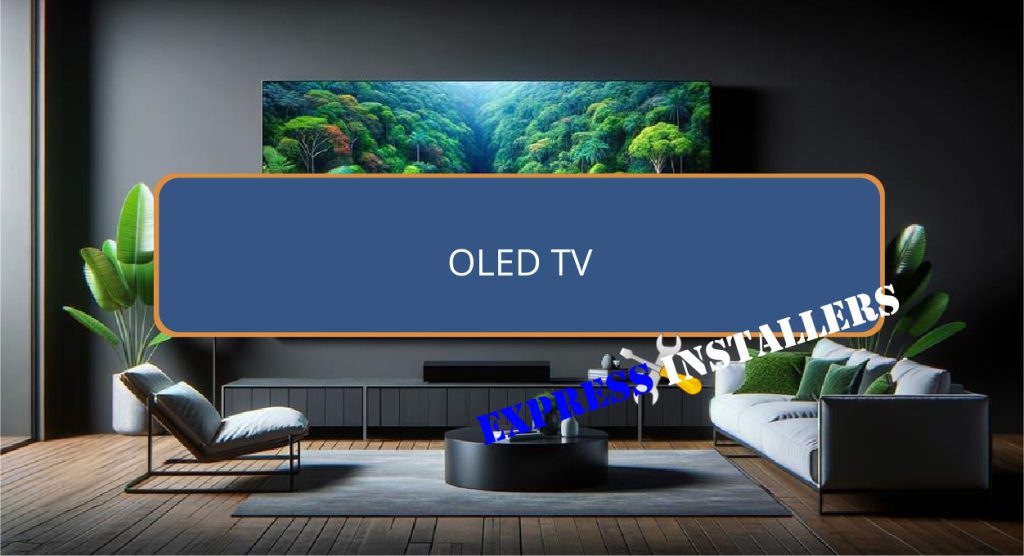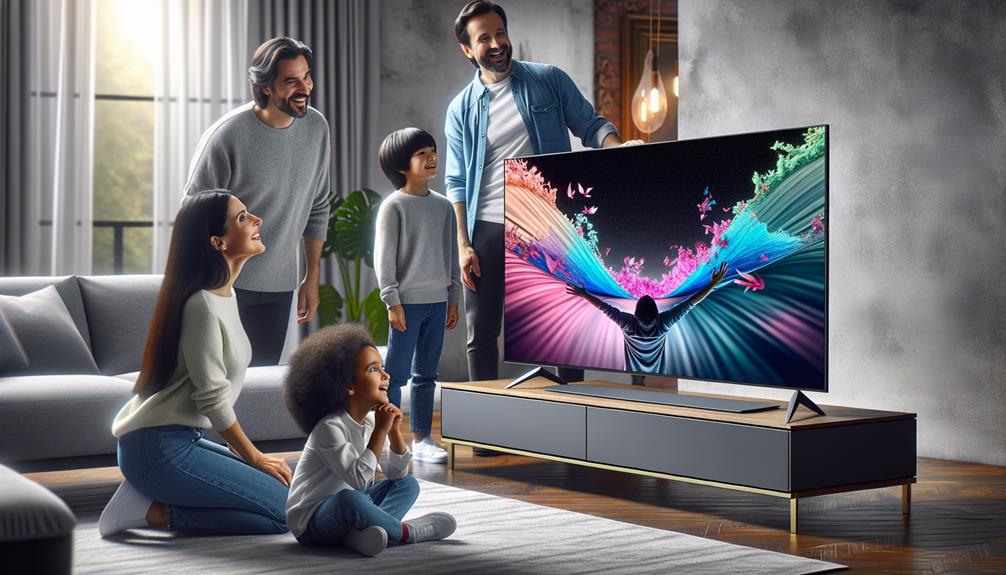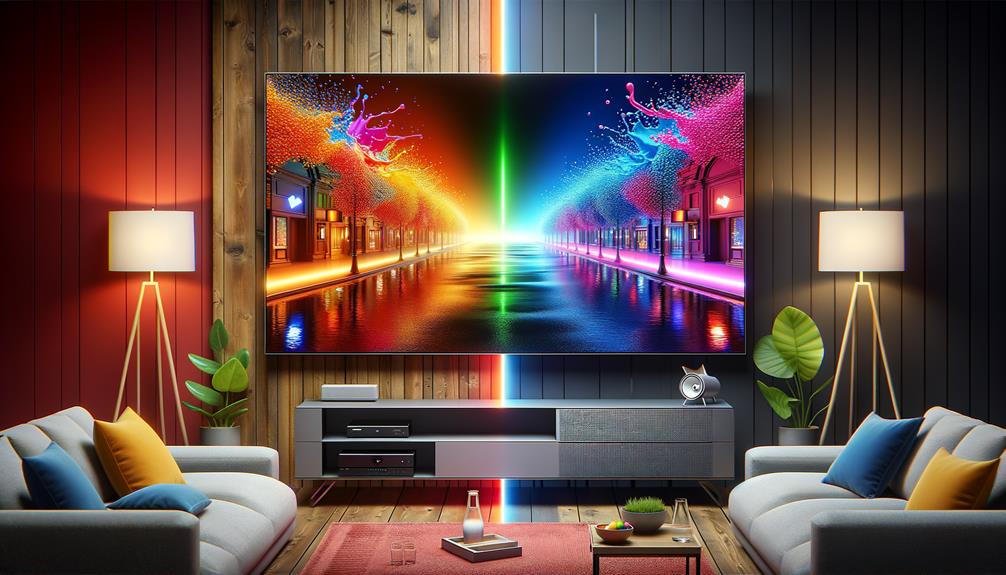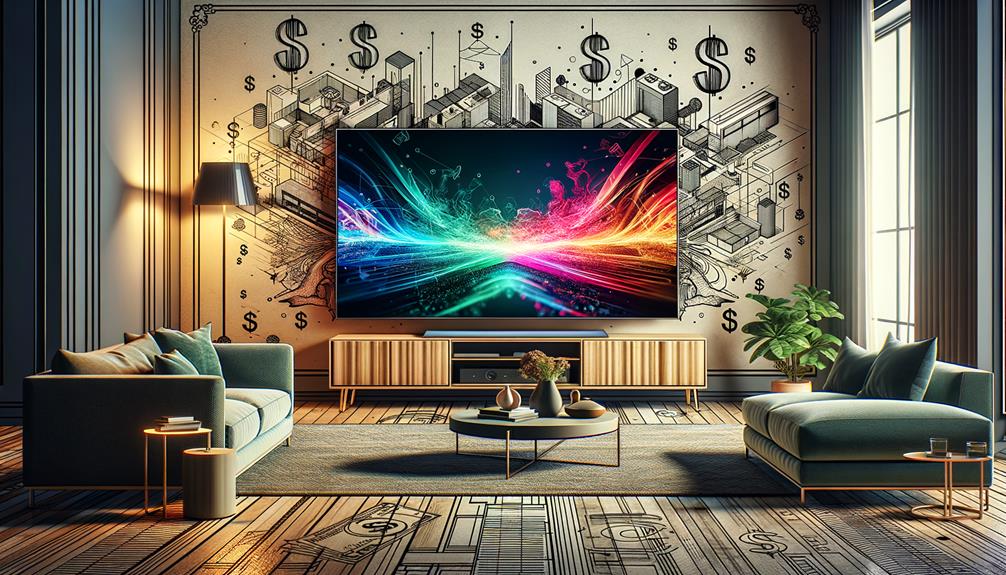
You should choose an OLED TV for its superior picture quality, featuring perfect blacks, stunning contrast, and vibrant colours thanks to individual pixel control.
Models like the LG G4 and Sony A95L offer exceptional brightness and color accuracy.
Unlike QLEDs, OLEDs deliver better gaming performance and consistent image quality from various angles. While OLEDs excel in dark-room settings, QLEDs are better for bright rooms.
Concerns over burn-in and firmware updates are worth noting, but the picture quality and feature-rich platforms make OLEDs a worthwhile investment.
Explore further to discover in-depth reviews, comparisons, and maintenance tips.
Get a discount with Express Installers. Express Installers has been installing TVs for over 20 years and has built relationships with major suppliers. We pass the discounts on to you and can offer top-notch installation of your new OLED TV.
Don’t just take our word for it; check out our Independent TV Installation Reviews
Quick Summary
- OLED TVs offer perfect black levels and stunning contrast due to individual pixel control.
- Top models include LG G4, C3, C4, Sony A95L, and Samsung S95C.
- OLED TVs excel in color accuracy and gaming performance compared to QLED.
- Regular firmware updates enhance performance, security, and functionality of OLED TVs.
- Get cheaper with Express Installers and benefit from our professional Same-day Installation service.
Advantages of OLED TV

One of the standout advantages of OLED TVs is their individual pixel control, which allows for perfect black levels and stunning contrast that surpass traditional LED TVs.
This feature isn’t just about deep blacks; it dramatically enhances the overall picture quality, giving you vibrant colors and high brightness levels.
When it comes to energy efficiency, OLED TVs also shine. Since each pixel emits its own light, there’s no need for a backlight, resulting in lower power consumption, particularly in scenes dominated by darker colors.
From a design aesthetics perspective, OLED screens are impressively thin and light, making them ideal for sleek, modern interiors.
Whether you’re mounting it on the wall or placing it on a stand, the minimalist design will effortlessly blend into your space.
For gamers, OLED TVs offer superior gaming performance. The self-emitting pixels provide faster response times, reducing motion blur and input lag, which are critical for an immersive gaming experience.
Plus, with larger screen sizes becoming more common, you get a more engrossing experience without compromising on image quality.
Wide viewing angles guarantee that everyone in the room enjoys consistent picture quality, no matter where they’re seated.
Top OLED TV Models
When evaluating the top OLED TV models, it’s crucial to consider factors like refresh rate, peak brightness, and HDMI 2.1 support to determine which one best suits your viewing needs.
The LG G4 OLED, available in sizes from 55 to 83 inches, features a 120 Hz refresh rate and nearly 1,500 nits of peak brightness, making it a standout in OLED technology advancements.
For a more budget-friendly option, the LG C3 OLED offers sizes from 42 to 83 inches, four HDMI 2.1 ports, and excellent value, especially for smaller sizes under £1,000.
Sony’s A95L, considered one of the brand’s best OLED TVs, excels in picture quality, making it a strong contender among popular OLED TV brands.
Gaming enthusiasts might prefer the LG C4 OLED, which offers a webOS smart platform, a 120 Hz refresh rate, and enhanced peak brightness compared to its predecessor, along with four HDMI 2.1 ports.
The Samsung S95C, LG B3, and Sony A80L each cater to different preferences and budgets, providing unique features and benefits.
From the budget-conscious to those seeking high-end performance, these models showcase significant OLED technology advancements, ensuring a premium viewing experience.
OLED Vs. QLED

In the battle between OLED and QLED technologies, understanding the key differences in pixel illumination and brightness capabilities is crucial for making an informed choice.
OLED TVs boast self-lighting pixels, giving you pure blacks and limitless contrast. This makes them ideal for dark environments and cinematic experiences.
QLED TVs, such as Samsung’s Neo QLED, leverage quantum dot technology to deliver higher brightness levels, which are perfect for well-lit rooms and daytime viewing.
When it comes to color accuracy, OLED TVs excel by offering more precise color reproduction due to each pixel emitting its own light.
QLED TVs, however, use a backlight that may sometimes lead to less accurate colour representation, but they make up for it with their superior brightness.
For gaming performance, OLED TVs often have faster response times and lower input lag, making them a favorite among gamers.
However, QLED TVs can also offer excellent gaming experiences, especially in brightly lit rooms.
Here are some key points to bear in mind:
- Pure blacks and contrast: OLED
- Brightness levels: QLED
- Color accuracy: OLED
- Gaming performance: OLED
Factors to Consider
When evaluating OLED TVs, you’ll need to compare display quality. This involves considering color accuracy, contrast ratios, and pixel response times.
Assess price and value by balancing the cost against features like HDR support and refresh rates.
Display Quality Comparison
Evaluating the display quality of OLED TVs involves scrutinising key factors like black levels, contrast ratios, colour accuracy, and viewing angles.
OLED technology excels in these areas, providing unparalleled visual experiences.
When it comes to color accuracy comparison, OLED TVs are excellent. Each pixel emits its own light, resulting in precise color reproduction.
This technology guarantees that hues are vibrant and true to life, which is important for both casual viewers and professional content creators.
Viewing angle benefits are another significant advantage of OLED TVs. Unlike traditional LED panels, OLED screens maintain consistent image quality from various positions in the room.
This feature is important for group viewing, as everyone gets the same high-quality visual experience, regardless of their seating position.
To summarise, here are key points to take into account:
- Black Levels and Contrast Ratios: OLED TVs deliver true blacks and infinite contrast ratios, enhancing depth and realism.
- Color Accuracy: Self-emissive pixels provide precise color reproduction, making images vibrant and lifelike.
- Viewing Angles: Consistent image quality from various positions ensures everyone enjoys the same visual experience.
- HDR Support: Combined with self-emissive pixels, HDR support delivers exceptional detail and clarity.
Understanding these factors will help you appreciate why OLED TVs are considered superior in display quality.
Price and Value
While OLED TVs offer exceptional display quality, understanding their price and value can greatly influence your purchasing decision.
Pricing strategies vary across brands, impacting customer satisfaction. For instance, models like the Samsung QE55S90C are priced at £999, whereas the LG OLED55G46LS is £1,799.
Market trends and technological advancements also play a pivotal role in pricing.
| Model | Price |
|---|---|
| Samsung QE55S90C | £999 |
| LG OLED55G46LS | £1,799 |
| LG OLED77G45LW | Varies |
| Philips 42OLED808 | Varies |
Value-added deals can enhance customer satisfaction. Some LG TVs come with free soundbars, while Samsung offers half-price soundbars with the QE55S90C.
Special offers like 12 months interest-free credit on the LG OLED77G45LW or discounts on Philips sound bars with the Philips 42OLED808 are worth considering.
To assess value, compare features such as the Alpha 11 AI Processor on the LG OLED77G45LW and the Neural Quantum Processor 4K on the Samsung QE55S90C.
Added benefits, like free apps and subscriptions worth £260-£460 with the Samsung QE55S95D or a 100-day trial on the Philips 42OLED808, boost the overall value.
Understanding these factors helps you make an informed choice, aligning with current market trends and technological advancements.
Lifespan and Durability
Understanding the lifespan and durability of OLED TVs is crucial, given their impressive longevity of around 100,000 hours and the potential issues like screen burn-in that you should be mindful of.
OLED TVs are designed to last over 11 years of continuous use, but several factors can impact this lifespan, including your usage patterns, brightness settings, and the type of content you watch.
To maximise longevity and reliability, consider these maintenance tips:
- Adjust brightness settings: Lower brightness can reduce stress on the pixels, enhancing screen protection and extending the TV’s lifespan.
- Rotate content: Avoid static images and vary the content you watch to prevent screen burn-in, a common issue where static images leave a permanent mark on the screen.
- Use screen savers: Activate screen savers during idle periods to keep pixels active and evenly worn.
- Regular updates: Make sure your TV’s firmware is up to date, as manufacturers often release updates to improve performance and reliability.
OLED TVs are highly durable due to their lack of backlighting and individual pixel control, offering you an exceptional viewing experience when maintained properly.
By following these maintenance tips and focusing on screen protection, you can greatly enhance the longevity and reliability of your OLED TV.
Price Range and Value

OLED TVs, ranging from around £999 to £3999, deliver unmatched value due to their superior picture quality, vibrant colours, and deep blacks, making them an excellent investment for cinephiles and tech enthusiasts alike.
Even at the lower end of the price spectrum, budget options provide significant advantages over traditional LED and LCD screens.
The self-lighting pixels in OLED panels guarantee exceptional contrast ratios, offering a more immersive viewing experience.
Here’s a comparative table to visualise the price range and value:
| Price Range | Features | Value Proposition |
|---|---|---|
| £999 – £1499 | Entry-level OLED, 4K resolution | Affordable, excellent contrast |
| £1500 – £2499 | Mid-tier, advanced HDR, smart features | Superior color accuracy, smart tech |
| £2500 – £3499 | High-end, larger screens, AI upscaling | Cinematic experience, longevity benefits |
| £3500 – £3999 | Premium models, 8K resolution | Cutting-edge technology, future-proof |
The longevity benefits of OLED TVs are notable. Their energy-efficient design and durable materials guarantee they last longer than many other types of displays.
Despite the higher initial cost, the long-term savings on energy bills and the extended lifespan make OLED TVs a smart investment.
The superior visual performance and cutting-edge features will keep you satisfied for years, proving their value over time.
Common Concerns
When considering OLED TVs, you’ll need to address several common concerns such as burn-in risk, lifespan, and durability compared to other technologies.
OLED screens can suffer from image retention if static visuals are displayed for prolonged periods.
Additionally, while the picture quality is unparalleled, the higher price point often requires weighing the benefits against the potential drawbacks.
Burn-In Risk
Burn-in risk remains a prevalent concern among OLED TV users due to the technology’s inherent susceptibility to static images causing uneven pixel wear.
This phenomenon, known as burn-in, happens when static images like logos, news tickers, or video game HUDs persist on your screen for long periods, leading to permanent image retention.
To mitigate this risk and enhance screen longevity, manufacturers incorporate several preventive measures.
Features like pixel shifting and screen savers are designed to reduce the likelihood of burn-in by subtly moving the pixels or activating a screen saver during periods of inactivity.
Additionally, pixel refresher functions can help by recalibrating and equalising pixel wear.
As a user, you can adopt various strategies for burn-in prevention:
- Vary your content: Regularly change what you’re watching to prevent static images from lingering too long.
- Lower brightness: Reducing brightness can lessen the strain on pixels, thereby minimising the risk of image retention.
- Use built-in features: Enable pixel shifting and screen savers to keep your display in peak condition.
- Run pixel refresher: Utilise the pixel refresher feature periodically to maintain even pixel wear.
Lifespan and Durability
While burn-in remains an important concern, understanding the overall lifespan and durability of OLED TVs can help you make informed decisions about your investment.
OLED TVs typically boast a lifespan of around 100,000 hours, translating to over a decade of continuous viewing.
This long term durability is impressive, but it’s essential to contemplate maintenance tips to preserve screen quality.
Burn-in, resulting in image retention, can occur if static images are displayed for extended periods.
However, modern OLED technology has evolved to mitigate these risks. Newer models incorporate features like automatic pixel shifting and pixel refreshers to combat image retention.
Implementing screen protection strategies, such as using screen savers and varying content, can further enhance the lifespan.
Additionally, adjusting brightness settings and avoiding prolonged display of static images are practical measures to ensure long term durability.
Price Comparison
Comparing prices across various OLED TV models can reveal significant differences and potential savings, making it important to evaluate the cost-to-feature ratio to guarantee you’re getting the best value for your investment.
When considering options like the Samsung QE55S90C at £999 or the LG OLED55G46LS at a price of 1,799, it’s crucial to look beyond the sticker price.
Energy efficiency comparison is significant. More energy-efficient models can save you money in the long run, reducing your overall cost of ownership.
Warranty options also play a critical role, as a longer warranty can offer peace of mind and potential savings on future repairs.
Eco-friendly materials used in the construction of these TVs can also be a deciding factor for the environmentally conscious buyer.
Installation tips provided by manufacturers can help you set up your new OLED TV efficiently, saving both time and additional installation costs.
- Samsung QE55S90C: Affordable at £999 with a solid feature set.
- LG OLED55G46LS: Higher price.
- Panasonic TX-65MZ800B: Mid-range price with a 50 discount.
- Philips 42OLED808: Includes a 100-day trial and soundbar discounts.
Evaluating these factors ensures you make an informed decision tailored to your needs and budget.
Frequently Asked Questions
What Does OLED Mean on a TV?
OLED technology means Organic Light-Emitting Diode. It lets each pixel light up individually, offering display benefits like deeper blacks, vibrant colors, and limitless contrast. You’ll notice superior picture quality, especially in dark scenes.
What Are the Disadvantages of OLED TV?
You might face screen uniformity issues and higher energy consumption compared to other technologies. Additionally, brightness levels are lower, they’re susceptible to burn-in, and they’re more expensive, especially with a shorter lifespan due to organic materials used.
What Is Better, OLED or QLED?
You’ll find OLED offers superior colour accuracy and viewing angles, making it perfect for immersive experiences. However, QLED excels in brightness, ideal for well-lit rooms. Choose based on your environment and viewing preferences.
Is OLED TV Better Than 4k?
You’ll find OLED TVs superior to standard 4K TVs due to their exceptional picture quality and viewing angles. OLED’s self-lighting pixels provide perfect blacks, deeper contrast, and vibrant colours, enhancing your viewing experience greatly.
Conclusion
Overall, OLED TVs offer unparalleled picture quality, deep blacks, and energy efficiency, making them a top choice for discerning viewers.
When comparing OLED and QLED, OLED’s self-emissive pixels provide superior contrast and viewing angles.
Consider factors like price, screen size, and brand reputation before investing. Though OLEDs are generally pricier, their value in terms of visual experience is unmatched.
Keep common concerns like burn-in in mind, but overall, OLED TVs remain a stellar option for top-tier home entertainment.
Contact Express Installers today to find out how much cheaper we can get it, plus take advantage of our same-day TV wall mounting service.
